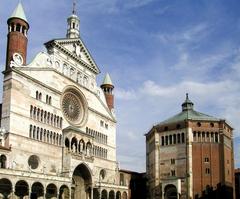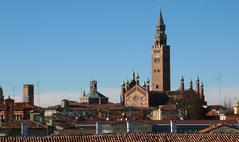San Lorenzo Archaeological Museum Cremona: Visiting Hours, Tickets, and Historical Sites Guide
Date: 03/07/2025
Introduction
Located in the heart of Cremona, Italy, the San Lorenzo Archaeological Museum is both a remarkable cultural institution and an architectural landmark. Housed within the evocative 12th-century Romanesque church of San Lorenzo—built on top of a 5th-century early Christian burial ground—the museum offers a unique lens on Cremona’s history, from its Roman foundation in 218 BCE through the early Middle Ages. With over 1,500 artifacts, innovative digital experiences, and a commitment to accessibility, the museum is an essential destination for anyone interested in archaeology, history, or inclusive cultural tourism (Museo per Tutti, Inexhibit).
Table of Contents
- Introduction
- Historical Context and Significance
- Collections and Exhibitions
- Museum Layout and Visitor Experience
- Visiting Hours, Tickets, and Travel Tips
- Accessibility and Technological Innovations
- Nearby Attractions
- Frequently Asked Questions (FAQ)
- Visual and Digital Resources
- Conclusion & Call to Action
- References
Historical Context and Significance
Roman Foundations and City Evolution
Founded as a Roman colony in 218 BCE, Cremona was the first such settlement north of the River Po. Its strategic location along the Via Postumia and proximity to the Po River contributed to its economic and military importance. Cremona’s Roman period saw the growth of public buildings, a thriving port, and the establishment of a Sarmatian military unit and imperial shield factory (Museo per Tutti).
The San Lorenzo Site
The museum stands within the former church of San Lorenzo, a 12th-century Romanesque structure built atop a 5th-century Christian burial ground. This layered history is visible in the architecture and archaeological remains, reflecting Cremona’s resilience and transformation following invasions and periods of destruction (Inexhibit).
Collections and Exhibitions
Thematic Structure
The museum’s exhibition is divided into three principal realms:
1. Public Spaces and Civic Life:
Artifacts from theatres, temples, and civic buildings illustrate the sophistication of Roman urban society. Highlights include architectural fragments, mosaics, and Latin inscriptions that reveal the political and social life of ancient Cremona (Museo per Tutti).
2. Private Spaces—The Domus:
Explore reconstructions and artifacts from affluent Roman houses like the Domus del Labirinto and Domus del Ninfeo. Mosaics, frescoes, jewelry, and household items are displayed alongside immersive digital reconstructions using Oculus VR technology (Artsupp).
3. Necropoleis and Funerary Culture:
Funerary monuments, stelae, and grave goods reveal burial customs and beliefs about the afterlife. The 5th-century Christian burial ground beneath the museum is a key link to Cremona’s early medieval history (Museo per Tutti).
Museum Layout and Visitor Experience
Architectural Setting
The museum’s layout integrates the original church architecture. The nave and aisles serve as exhibition galleries, while chapels and the sacristy host temporary exhibitions. Entry is through a former narthex orientation area with digital displays and maps introducing Cremona’s archaeological story (Comune di Cremona, Musei di Cremona).
Chronological Galleries
- Pre-Roman and Protohistoric Section: Early settlements and Bronze/Iron Age artifacts.
- Roman Section: The heart of the museum, showcasing mosaics, household objects, and funerary art.
- Late Antiquity & Early Middle Ages: Artifacts from Ostrogothic, Lombard, and early Christian periods.
Engagement and Interpretation
- Interactive Elements: Touchscreen kiosks, tactile models, and VR experiences.
- Educational Tools: Braille guides, easy-to-read materials, and multilingual audio guides.
- Guided Tours: Available in Italian and English by reservation (Musei di Cremona - Servizi Educativi).
Visiting Hours, Tickets, and Travel Tips
- Opening Hours: Tuesday–Sunday, 9:00 AM–6:00 PM (verify on official website for updates).
- Ticket Prices: €5–€8, with discounts for students, seniors, and groups. Children under 12 and Cremona residents enter free (Artsupp).
- Location: Via San Lorenzo 4/5, Cremona; about a 10-minute walk from the cathedral and railway station.
- Getting There: Easily accessible by public transport (bus lines 3 and 7) and within walking distance of major city attractions.
- Facilities: Accessible entrances, restrooms, gift shop, and a café in the former cloister.
Accessibility and Technological Innovations
Universal and Inclusive Design
- Physical Accessibility: Ramps, lifts, tactile floor indicators, accessible restrooms, and seating areas throughout the museum (MuseumNext).
- Multisensory Engagement: Tactile exhibits, Braille and audio guides, and sign language interpretation.
- Digital Collections: High-resolution images, 3D models, and virtual tours available online.
- Mobile App: Multilingual audio guides, interactive maps, and gamified learning experiences.
- Sensory-Friendly Hours: Reduced lighting and noise, sensory kits, and specialized programming for neurodiverse visitors.
- AI-Powered Personalization: The app suggests custom tour routes and interprets visitor feedback for continuous improvement.
- Educational Outreach: Inclusive workshops, large-print and easy-to-read materials, and partnerships with schools and accessibility organizations (ArchaeoReporter).
Nearby Attractions
Extend your visit to Cremona’s other cultural landmarks:
- Cremona Cathedral: Romanesque-Gothic masterpiece.
- Torrazzo: Iconic bell tower with panoramic city views.
- Museo del Violino: Celebrating Cremona’s world-famous violin-making tradition.
- Civic Museum Ala Ponzone: Art and history collections.
All are within walking distance, creating a rich, multi-stop cultural itinerary (In-Lombardia).
Frequently Asked Questions (FAQ)
What are the museum’s visiting hours?
Tuesday to Sunday, 9:00 AM–6:00 PM; closed Mondays and public holidays.
How can I buy tickets?
Purchase online via the official website or at the museum entrance.
Is the museum accessible for people with disabilities?
Yes. The museum provides ramps, lifts, accessible restrooms, tactile displays, and easy-to-read materials.
Are guided tours available?
Yes, reserve in advance online or at the ticket desk.
Is photography allowed?
Generally yes, without flash. Restrictions may apply in special exhibitions.
Visual and Digital Resources
- Museum Exterior: “Archaeological Museum San Lorenzo entrance in Cremona”
- Key Artifacts: “Roman mosaic from Domus of the Labirinto”, “Ancient Roman gold ring at San Lorenzo Museum”
- Virtual Experience: “Virtual reality tour of Roman domus at San Lorenzo Museum”
- Accessibility Features: Images of tactile displays, ramps, and app interface
All images should feature descriptive alt text for enhanced accessibility and SEO.
Conclusion & Call to Action
The San Lorenzo Archaeological Museum in Cremona is a leading example of how historic preservation, innovative technology, and inclusive design can come together to offer a transformative visitor experience. Whether you are an archaeology enthusiast, a family, or a traveler with accessibility needs, the museum welcomes you to explore centuries of history in a uniquely engaging environment.
Plan your visit today:
- Check current opening hours and ticket options on the official website.
- Download the museum’s mobile app for personalized guides and accessibility features.
- Explore related posts and follow us on social media for up-to-date news and events.
References
- Museo per Tutti - https://www.museopertutti.org/en/musei/museo-archeologico-san-lorenzo-eng/
- Comune di Cremona - https://musei.comune.cremona.it/it/museo-archeologico-san-lorenzo
- Artsupp - https://artsupp.com/en/cremona/musei/museo-archeologico-san-lorenzo
- MuseumNext - https://www.museumnext.com/article/what-are-the-innovations-of-museums/
- ArchaeoReporter - https://www.archaeoreporter.com/en/2024/03/25/how-technological-innovation-can-drive-greater-accessibility-and-inclusivity-in-archaeology/
- Stickymangorice - https://stickymangorice.com/2021/11/02/cremona-travel-guide/
- Savoring Italy - https://www.savoringitaly.com/cremona-italy/
- In-Lombardia - https://www.in-lombardia.it/en/tourism-in-lombardy/tourism-cremona/museums-cremona

